Reviewer's Note: The ITP SA1/SA2/SC1/SC2 were provided for review jointly by Battery Junction and Going Gear.
Warning: Even more pic heavy than usual! This is will be a round-up review of all four lights. oo:
oo:
Specifications for SA/SC family, according to BatteryJunction.com and GoingGear.com:
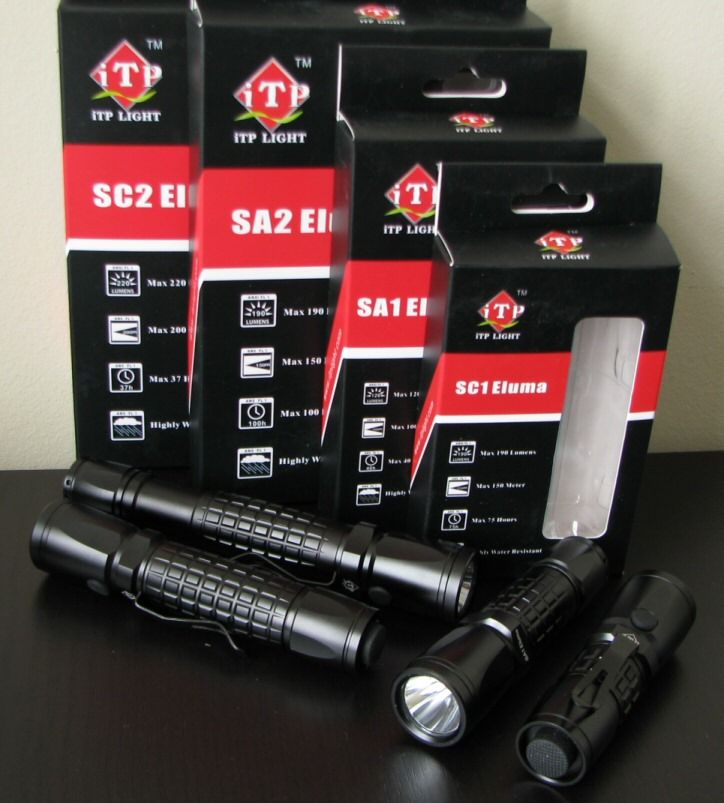
The SA/SC series are replacements for ITP's original entries into the LED flashlight world, the C7/C8/C9/C10 lights. Please see my earlier reviews for details of those lights.
This will be a round-up review of all four new SA/SC lights. In the first part of the review, I will provide a general overview of the common build features and design. In the second part, I will provide detailed output/runtimes and size comparisons for each light, with some general comments at the end.
Note: The SC2 will be shown as a representative sample in the pics below.
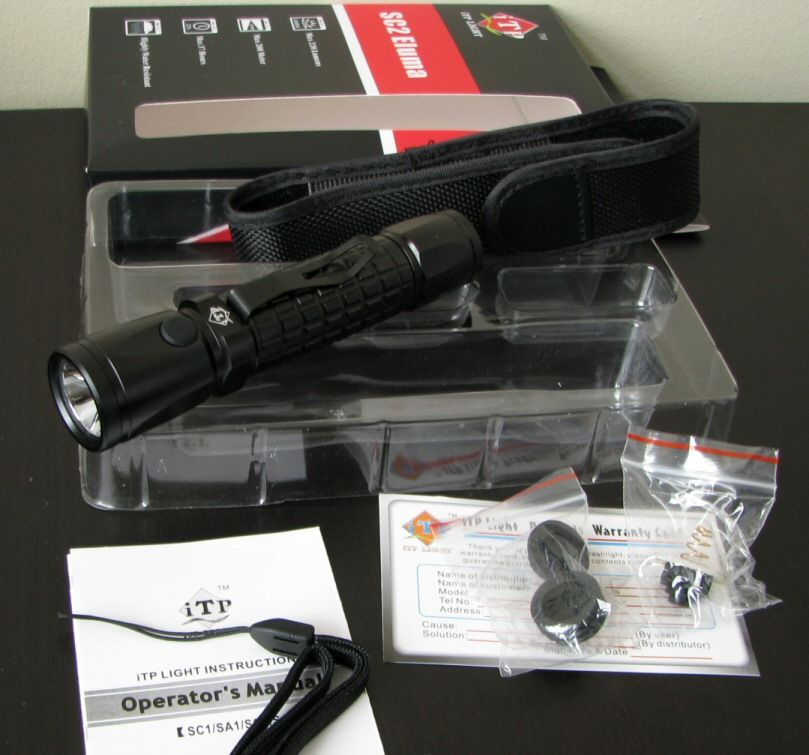
In keeping with their budget status, the ITP SA/SC lights come in fairly basic packaging – but include a reasonable number of extras. These include a decent quality carrying pouch with closing flap, simple wrist lanyard, replacement o-rings and low profile tailcap button, and a reverse clicky tail switch. Also included is a warranty card and manual. Note the pocket clip is built-in to the light.
UPDATE: As several members have pointed out, the replacement switch and boot cap are a reverse-clicky with lower profile, allowing tailstanding.
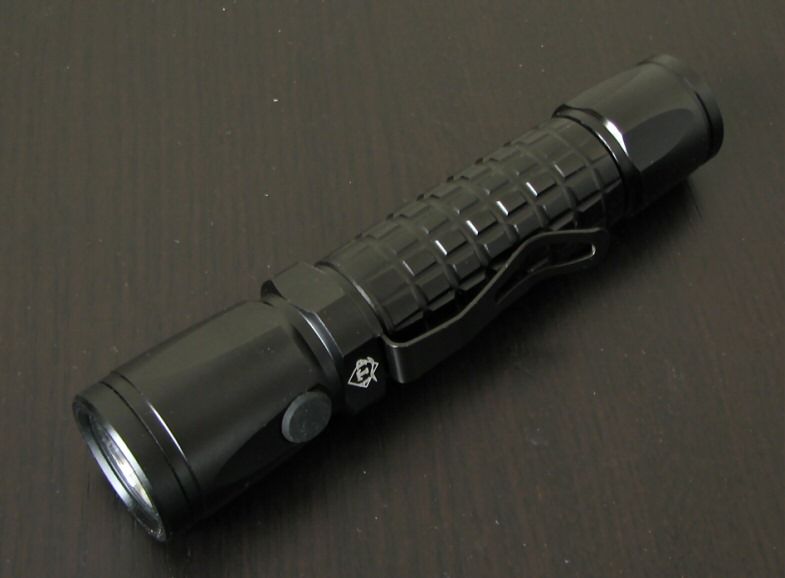

Fit and finish were good on all my samples, with no flaws in the black type-III hard anodizing. Identification labels are sharp and clear on all samples (something that wasn't always the case on my early sample C7/C8/C9 lights).
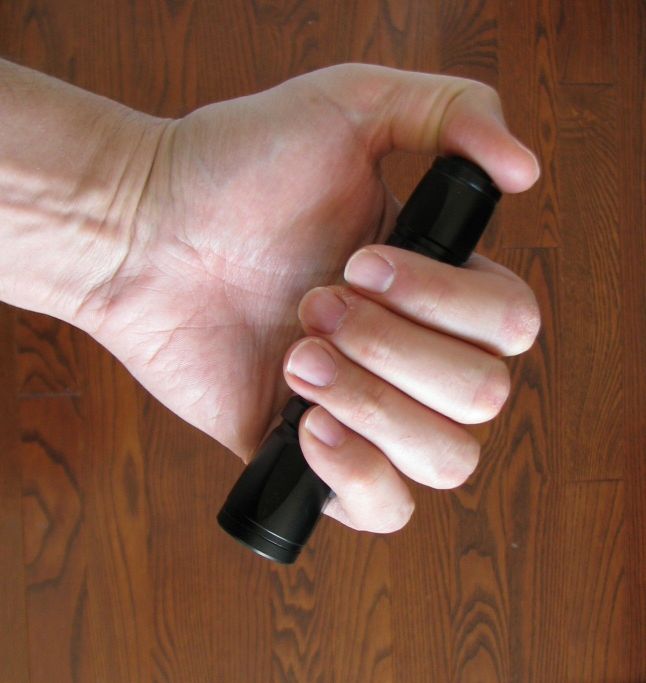
The attached stainless steel clip and checkered body pattern help with grip. I found all samples reasonably comfortable to hold in the hand. Note the presence of the front switch, on the head above the clip. This switch is a reverse clicky, and is used to control output modes. The rear tailcap (forward-clicky) controls on-off - see UI discussion below.
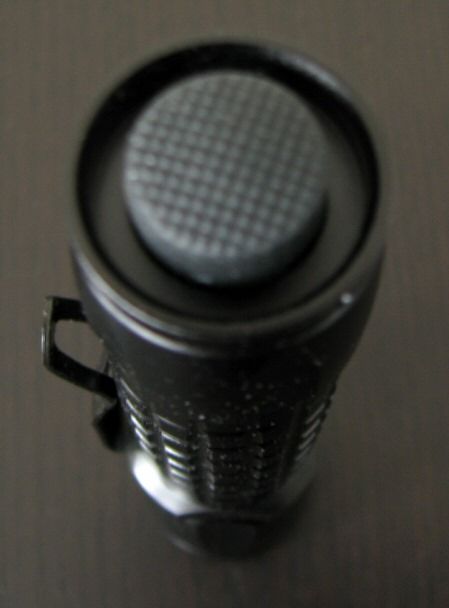
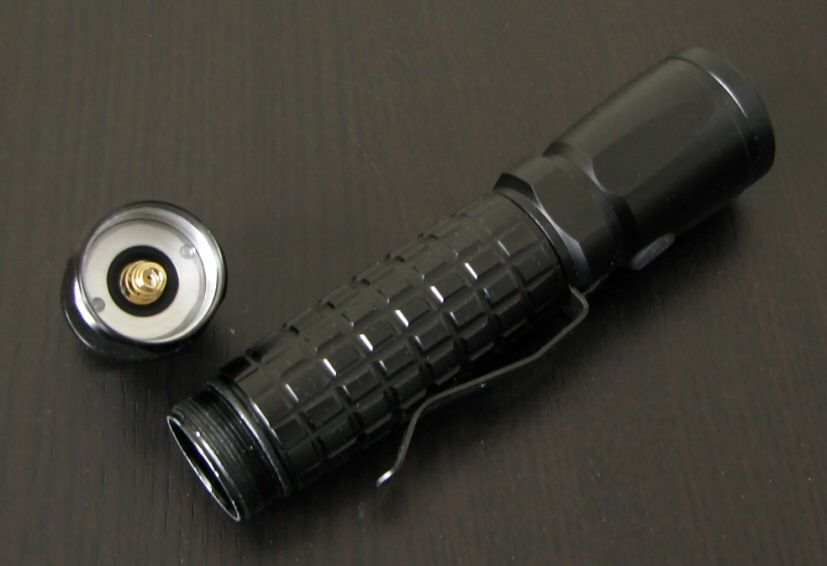
Tail screw threads are anodized for tailcap lock-out. :thumbsup: Note the lights cannot tailstand in its default form with the forward clicky. However, you can swap in the reverse clicky switch and low profile boot cover (included in the package) to restore tailstanding at the expense of momentary-on.
Unlike the earlier C-series, the head is not user-removable. Here's a shot down the battery/body tube:
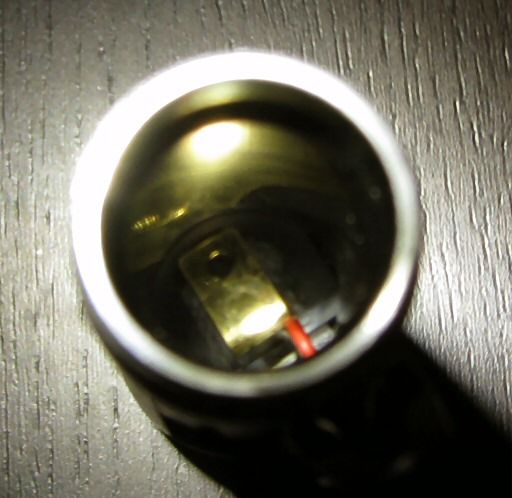
Similar to the budget MC-E-based ITP A6 Polestar, the positive contact surface is simply a piece of metal that has been folded-over. This is not particularly impressive. :sigh: There is certainly no physical reverse-polarity protection with this setup.
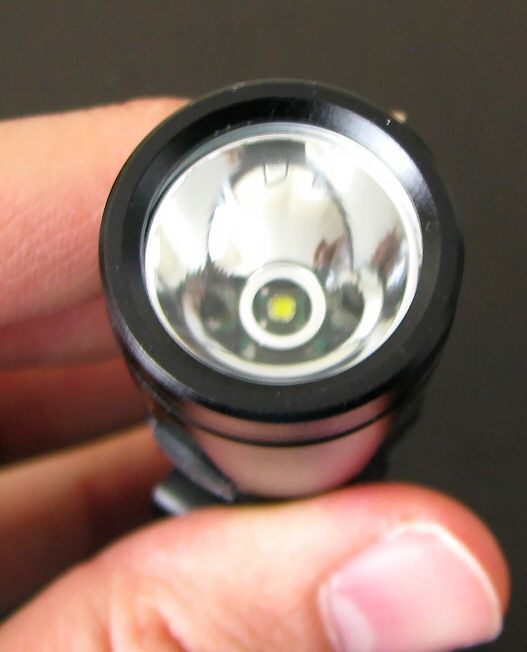
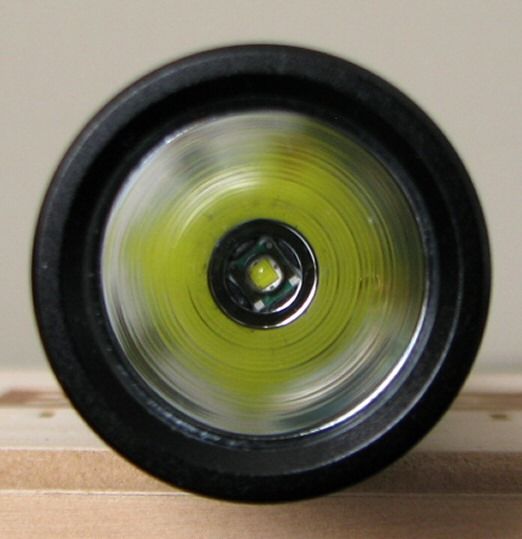
Unlike the earlier 2-stage reflector of ITP C-series and Olight T- and I-series lights, these new SA/SC lights have a smooth reflector that is not as deep. Actually, there seems to be very fine concentric rings all along the reflector, although these are subtle. They are likely there to help smooth out the beam somewhat.
These lights all use the new standard Cree XP-E emitter, with a R2 output bin (no tint bin reported). For those of you not familiar with tint bins, please see my Colour tint comparison and the summary LED tint charts found here.
For beamshot comparisons, I've chosen just the SA1 and SC2 below. All lights are on Max on either 1xSanyo Eneloop or 1xAW protected 14670/17670/18650 as appropriate, about 0.5 meters from a white wall.
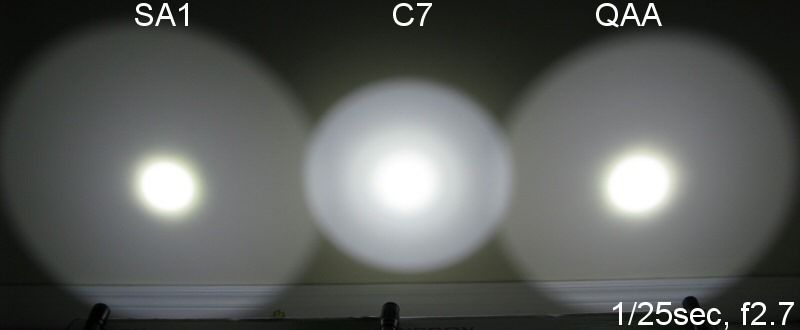
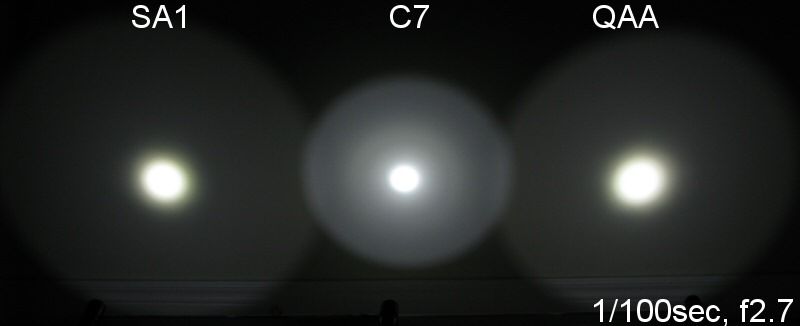
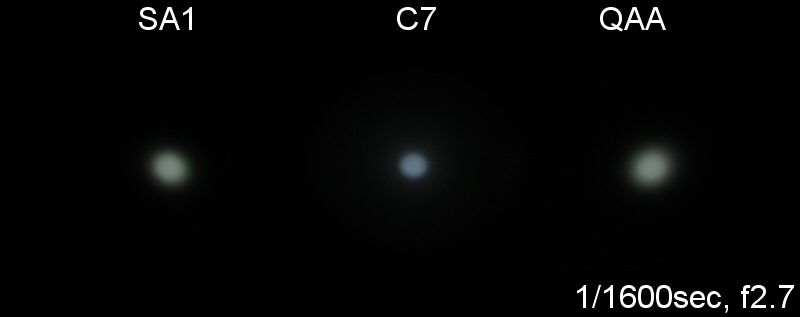
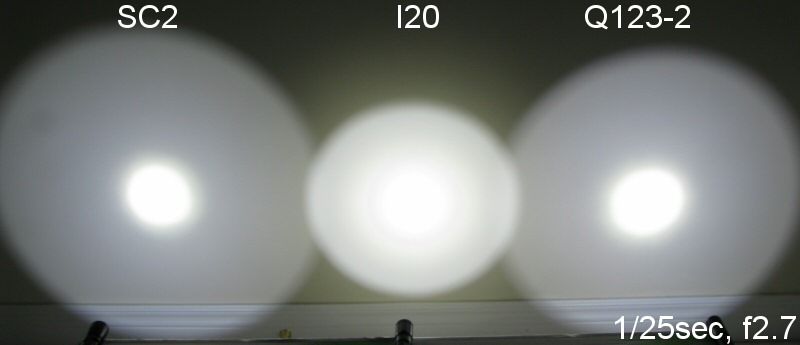
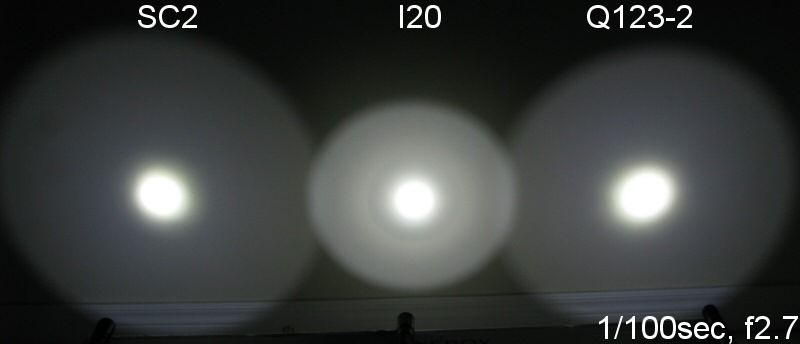
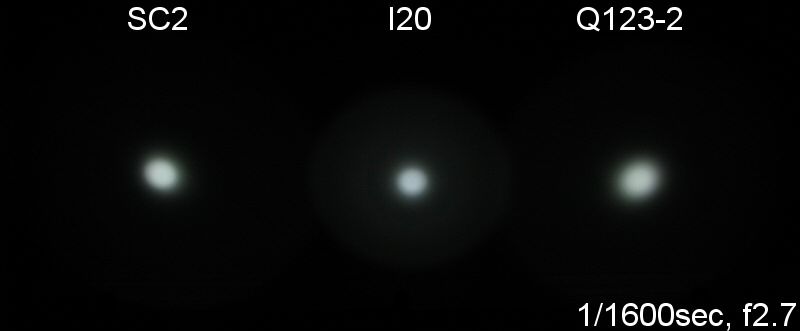
Note that I do not have an ITP C10 to directly compare, so I've used the Olight Infinitum I20 for the second set of beamshots above. The I20 uses the same reflector and similar circuit as the C10, so is directly comparable.
First thing you will notice is that the beam pattern is completely different from the earlier ITP/Olight series lights. In fact, this new emitter/reflector setup produces a pattern that is very similar to the 4Sevens Quark series – a medium intensity hotspot with a very wide and relatively dim spillbeam.
The reflector seems to do a good job of producing a smooth transition from hotspot to spill without rings.
User Interface
The SA/SC series have an updated interface. Similar to other lights that use dual switches, the rear tailcap switch controls on-off and the front head-mounted switch controls output modes.
Default rear switch is a forward clicky, so you can press for momentary-on, click for lock-on. :thumbsup: You can substitute the reverse clicky replacement switch and low-rise boot cover if you prefer to have a tailstanding option (note that this would prevent momentary signaling, though).
Front switch is a reverse clicky, and works in two ways. To change between preset output modes, press and release the switch repeatedly until you get the mode you want. Sequence is Lo-Med-Hi-Strobe, in repeating order. The light has a memory mode, and will remember the last setting upon re-activation.
To run through a continuously variable ramp, press and hold the front switch. Initially, the light will ramp from Lo to Hi, and back down from Hi to Lo, in a repeating fashion. Release the switch to select the desired output level. The variable output feature has a separate memory mode, and will retain the relative brightness setting the next time you initiate a ramp. Note the ramp speed is fairly quick (i.e. ~3 secs, see ramp graphs for each model below).
Note that the preset Lo and Hi modes correspond roughly to Min and Max on the continuously variable ramp.
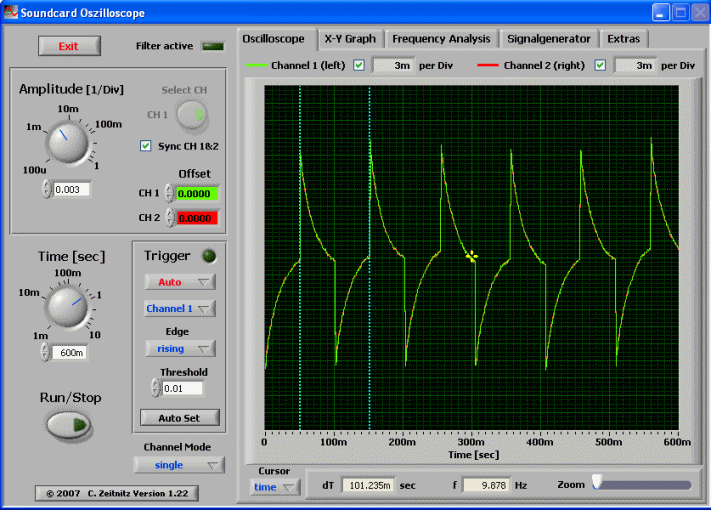
Strobe frequency was measured at just under 10Hz.
Consistent with earlier ITP/Olight continuously-variable lights, I was unable to detect the PWM frequency. The lights definitely use PWM, but the freq must be above >30kHz or so, as that is the upper detection limit in my setup. You won't be able to detect it by eye.
The lights definitely use PWM, but the freq must be above >30kHz or so, as that is the upper detection limit in my setup. You won't be able to detect it by eye.
Testing Method: All my output numbers are relative for my home-made light box setup, a la Quickbeam's flashlightreviews.com method. You can directly compare all my relative output values from different reviews - i.e. an output value of "10" in one graph is the same as "10" in another. All runtimes are done under a cooling fan, except for the extended run Lo/Min modes (i.e. >12 hours) which are done without cooling.
Throw values are the square-root of lux measurements taken at 1 meter from the lens, using a light meter.
Note: Effective January 2010, all CR123A runtimes are now performed solely on Titanium Innovations batteries sponsored by a BatteryJunction.com. You can compare the generally excellent performance of these CR123A cells relative to the Duracell/Surefire cells used in all my erlier reviews here. I have marked all the new runtimes of lights with Titanium Innovations CR123As on the graphs with an "*".
Size Comparison Pics, Throw/Output Summary Charts, Runtime Graphs, and Ramping Graphs will be provided for each respective light below.
--------------------------------------
SA1 (1xAA) Comparison
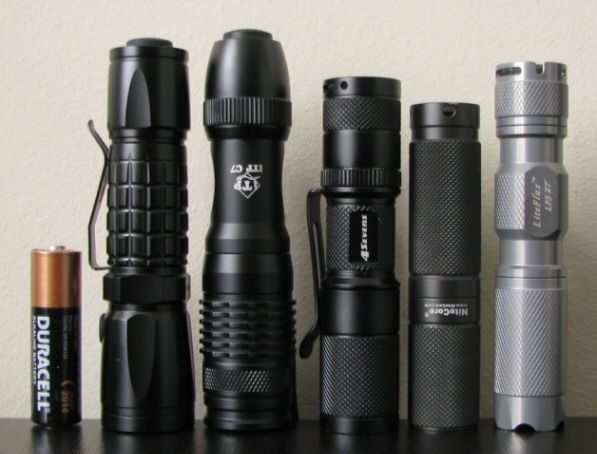
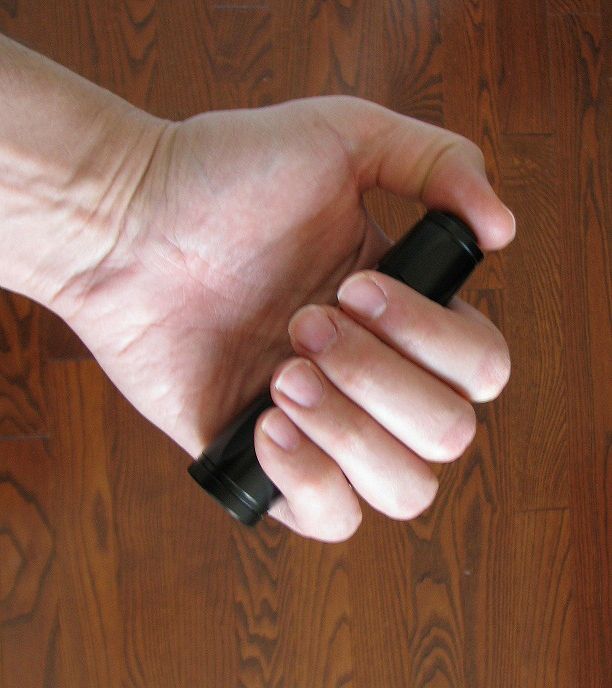
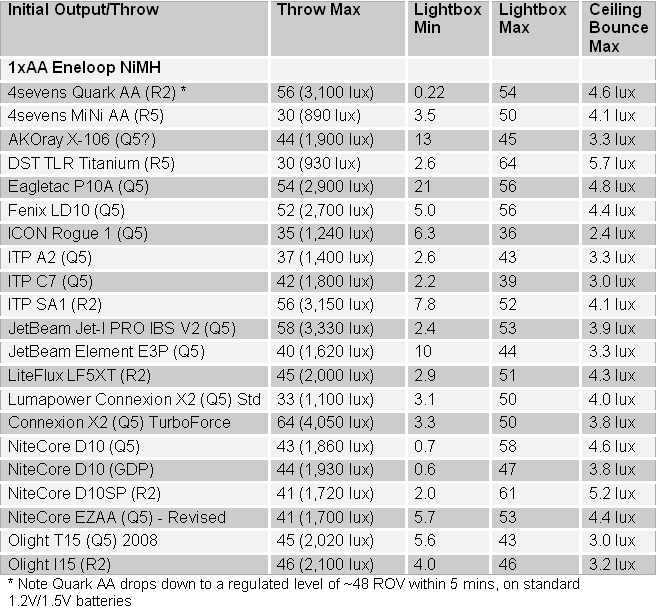
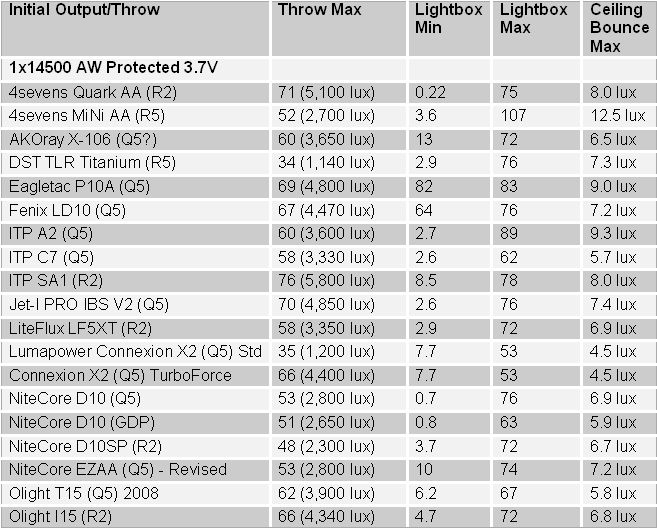
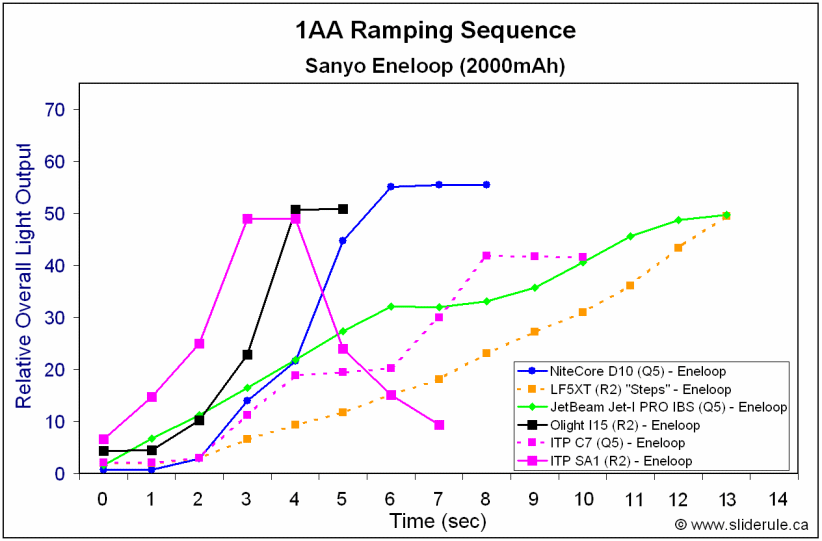
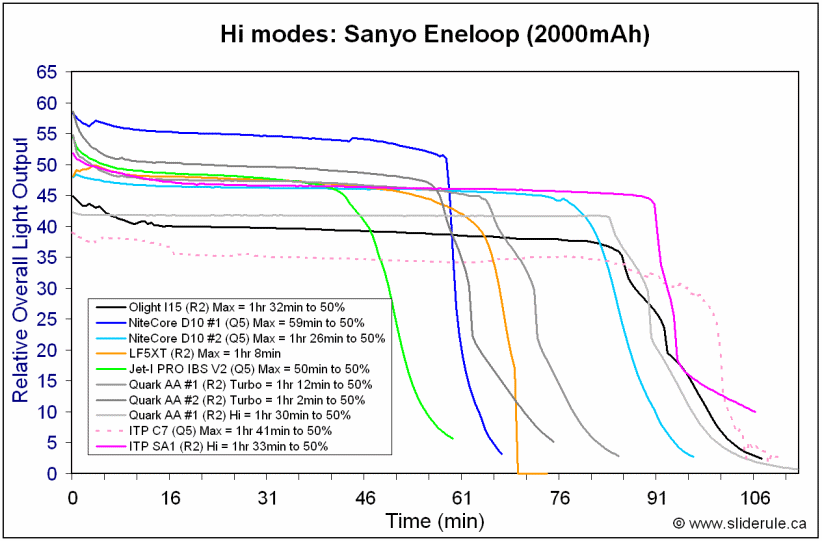
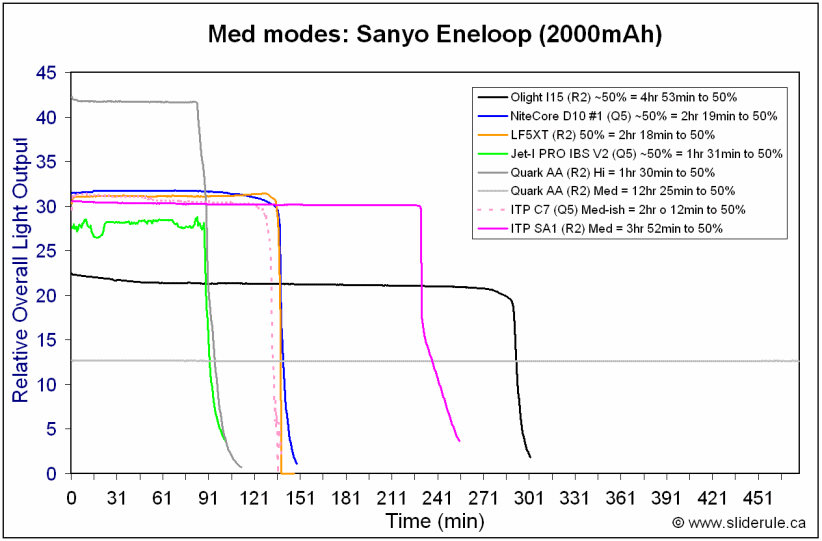
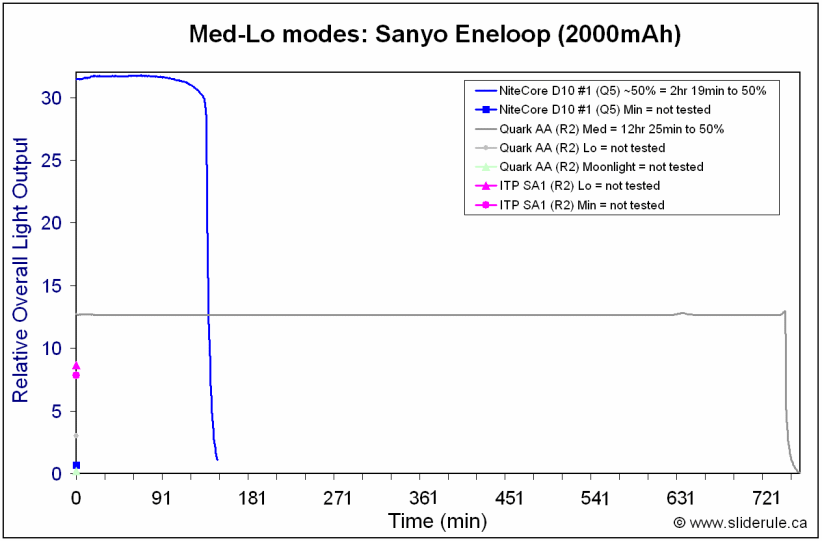
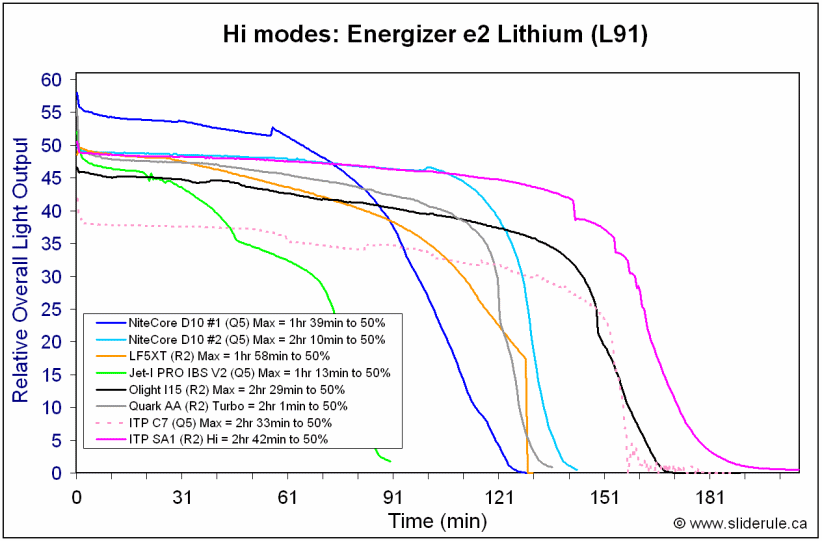
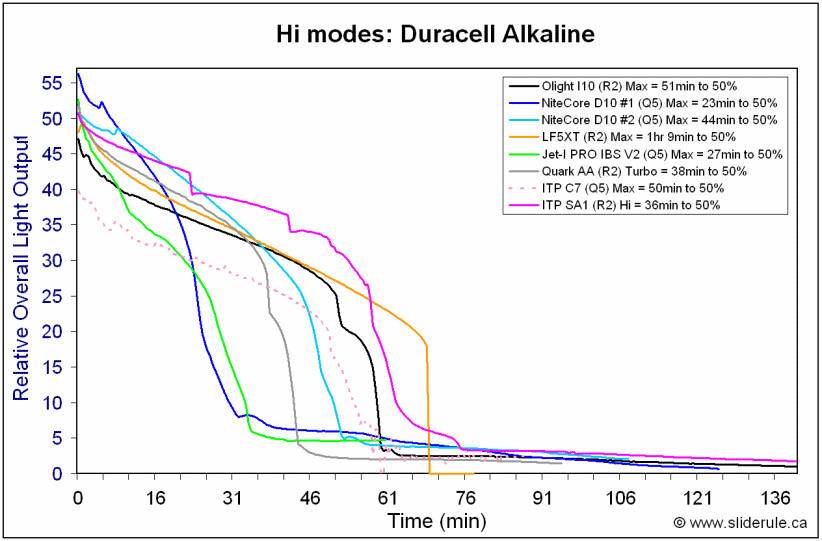
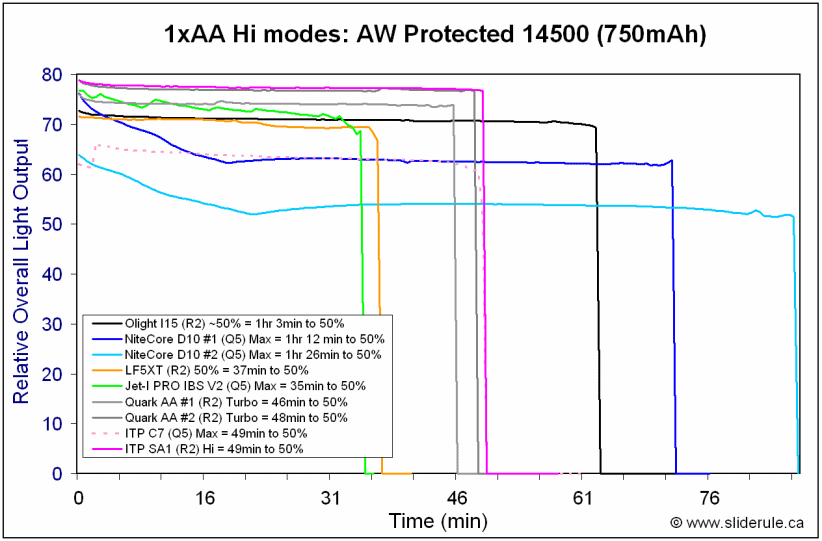
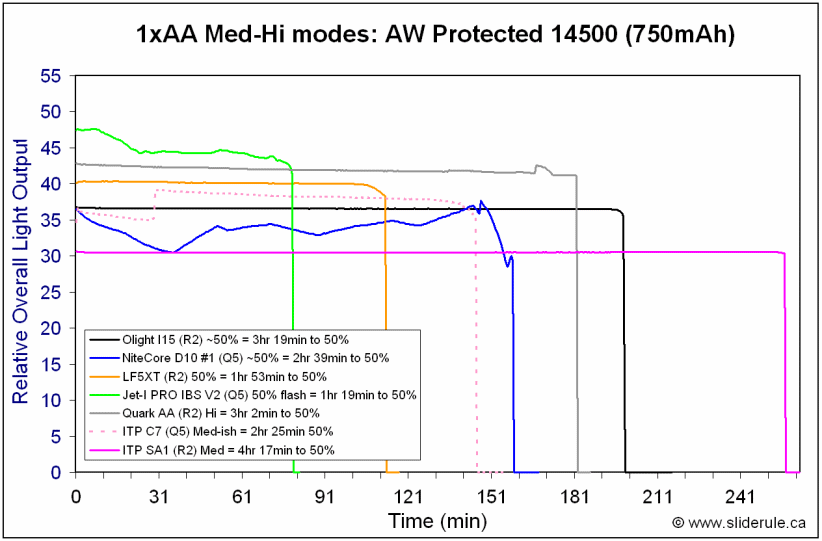
--------------------------------------
SA2 (2xAA) Comparison
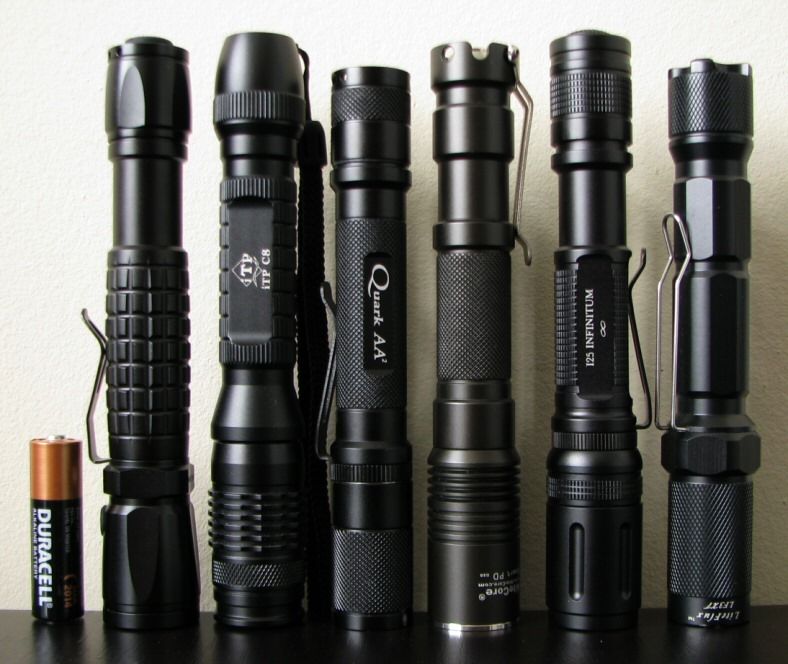
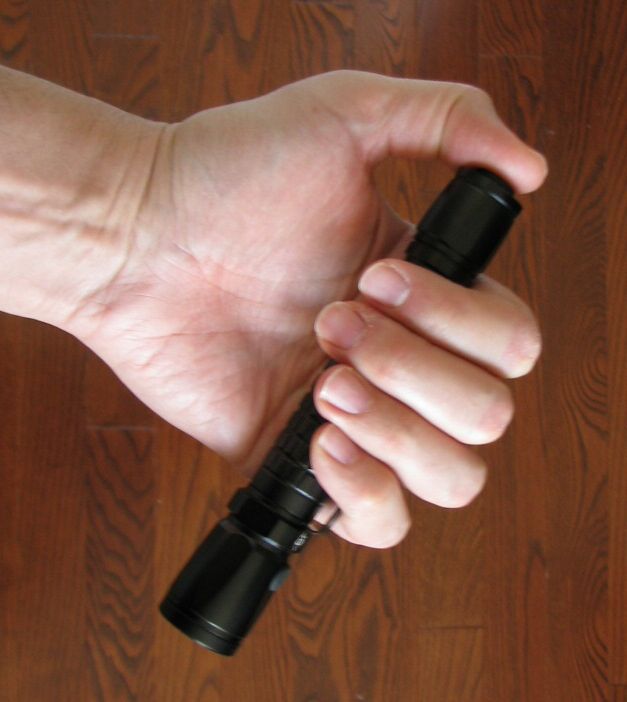
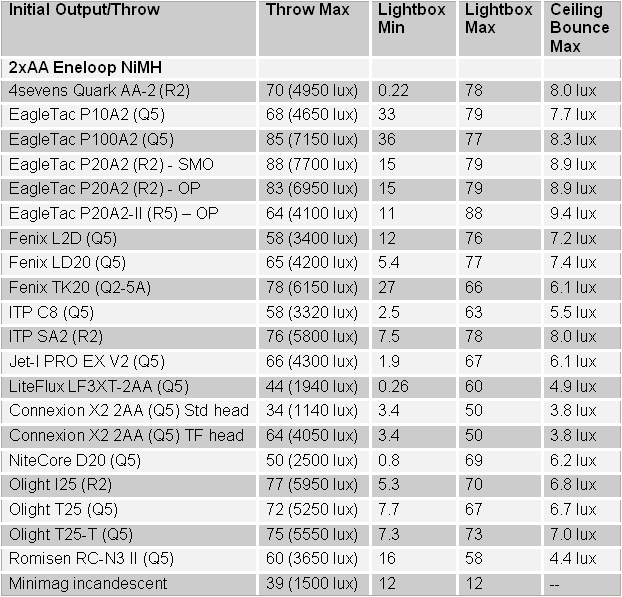
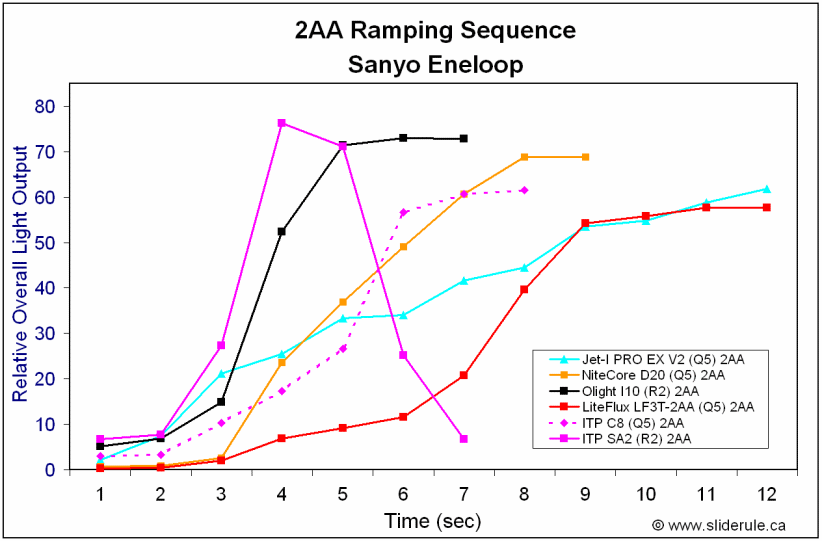
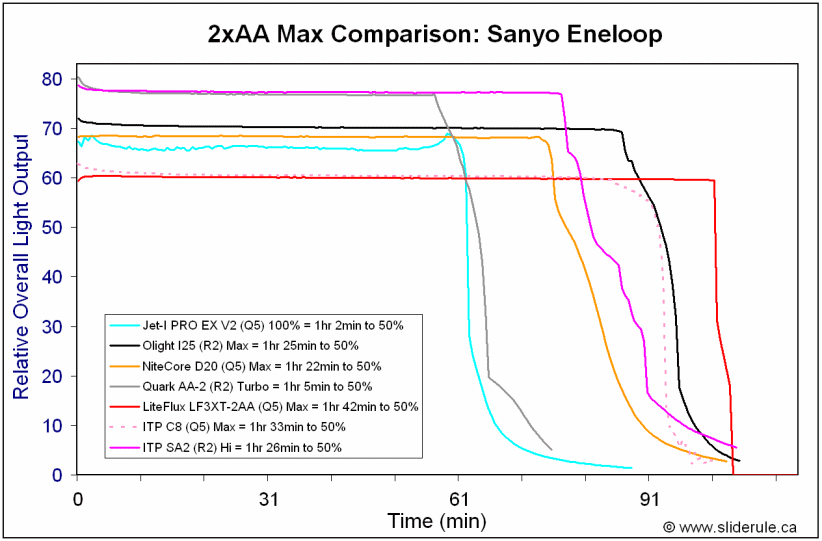
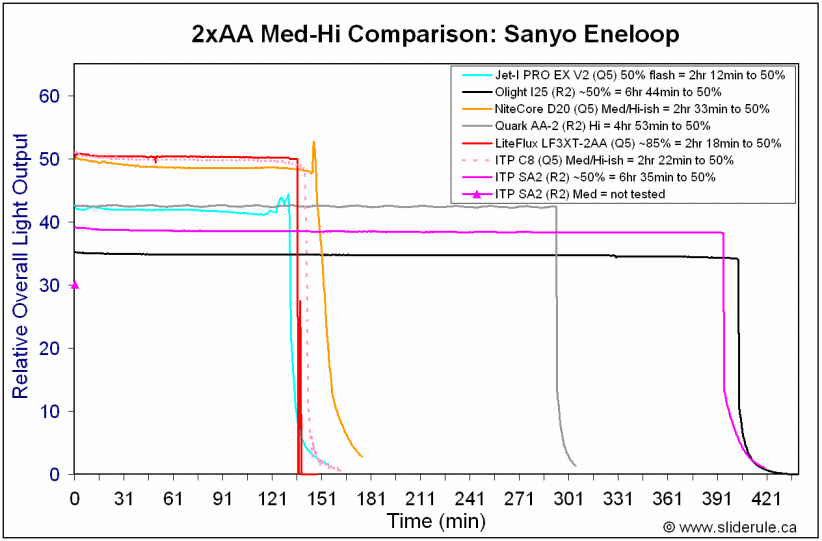
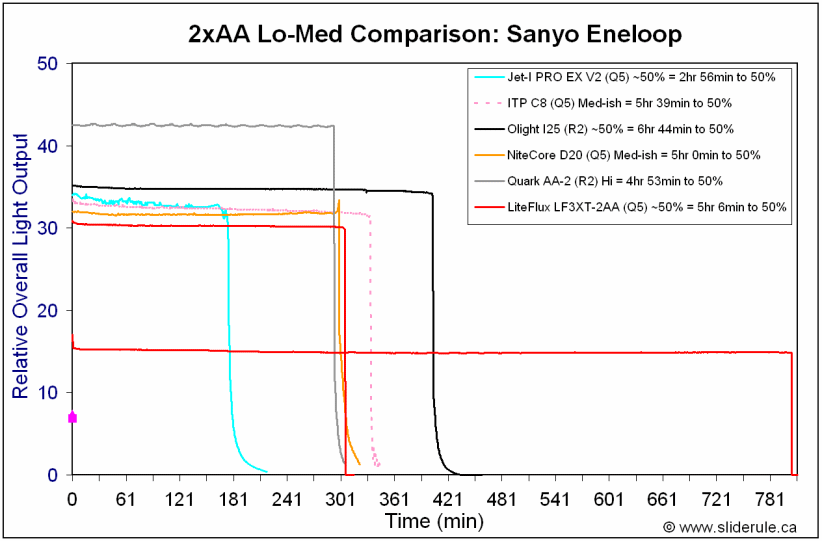
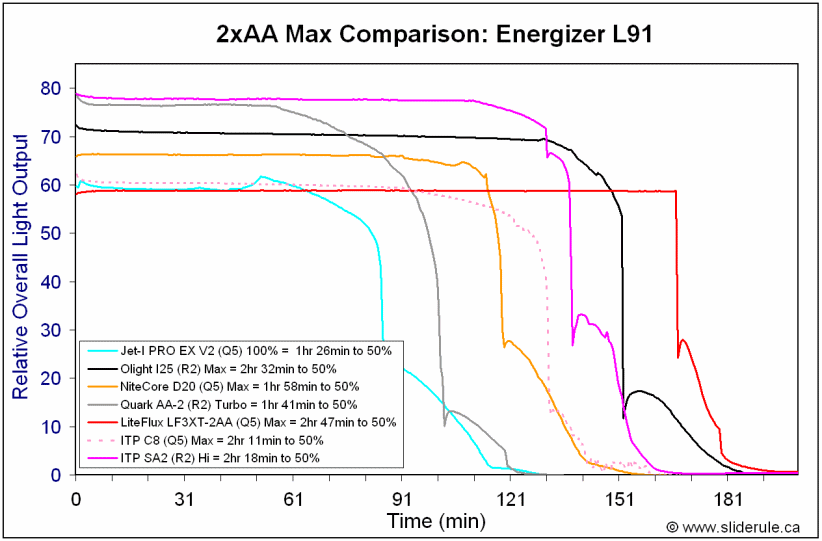
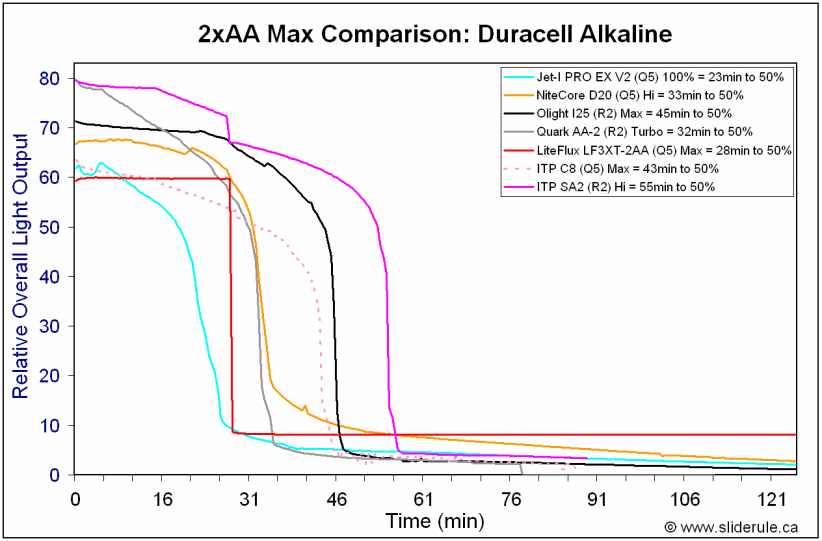
--------------------------------------
SC1 (1xR/CR123A) Comparison
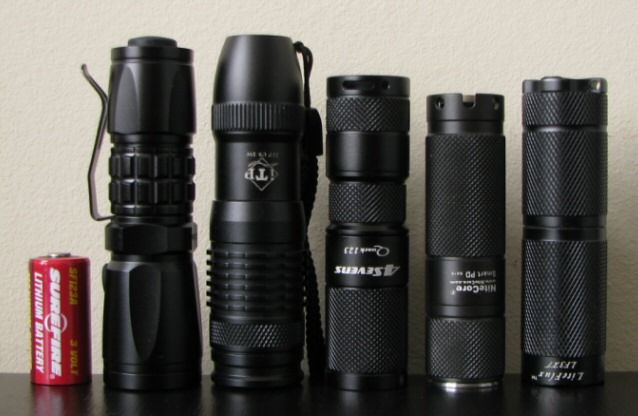
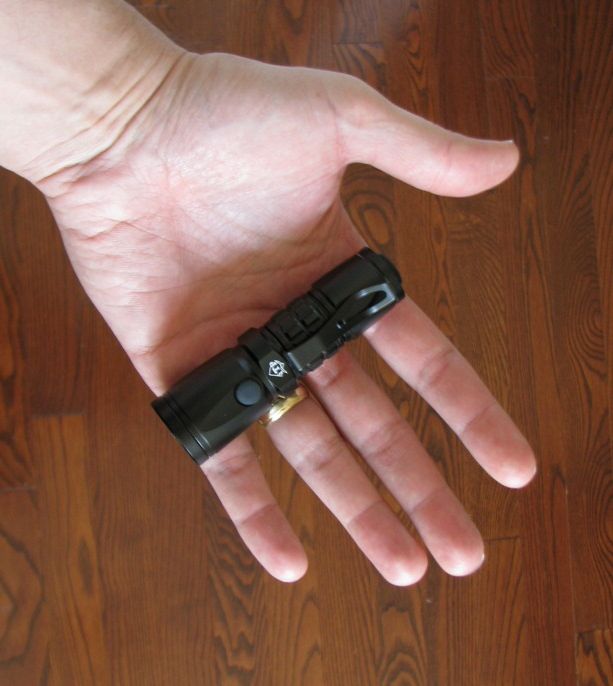
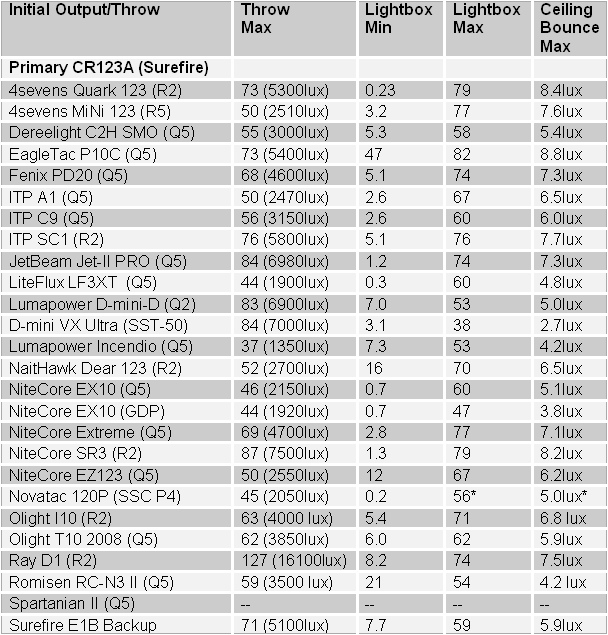
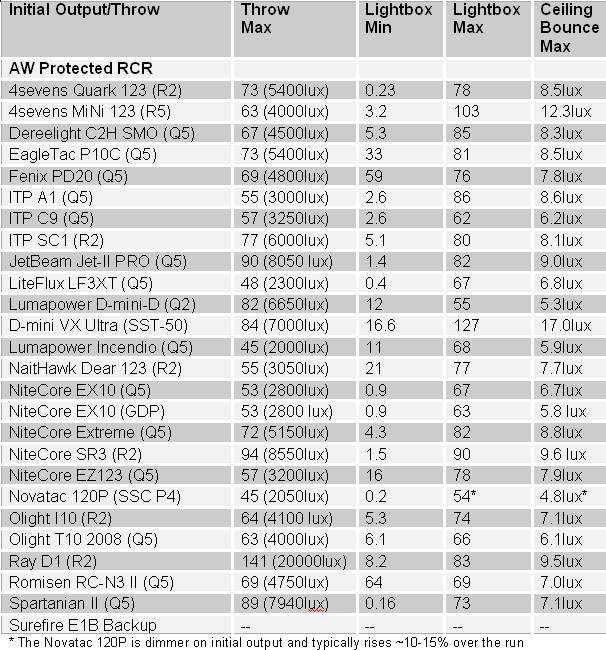
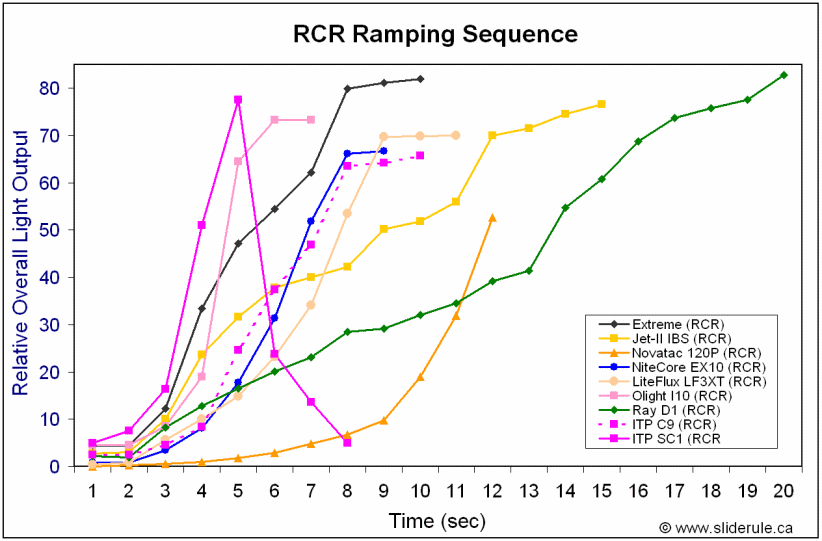
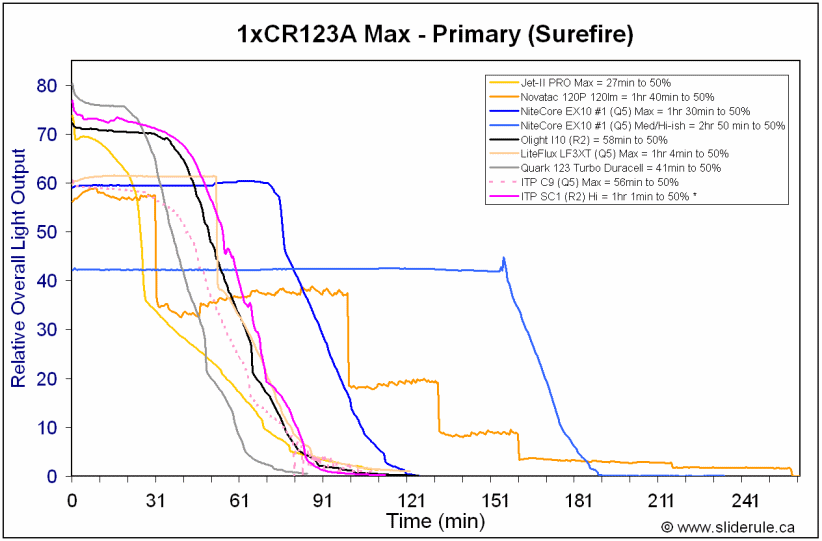
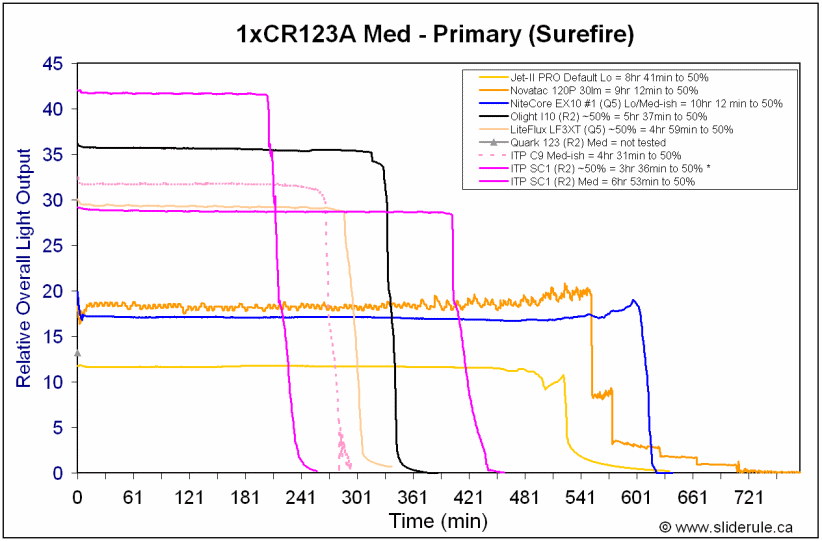
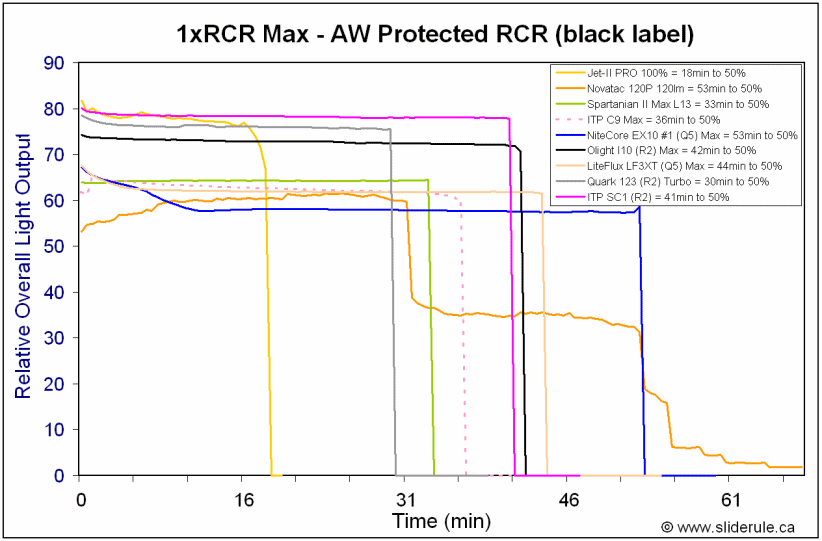
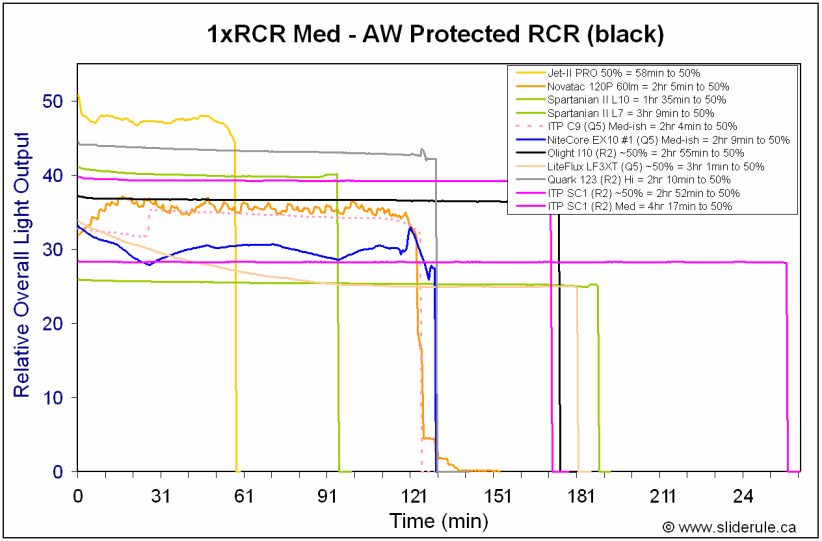
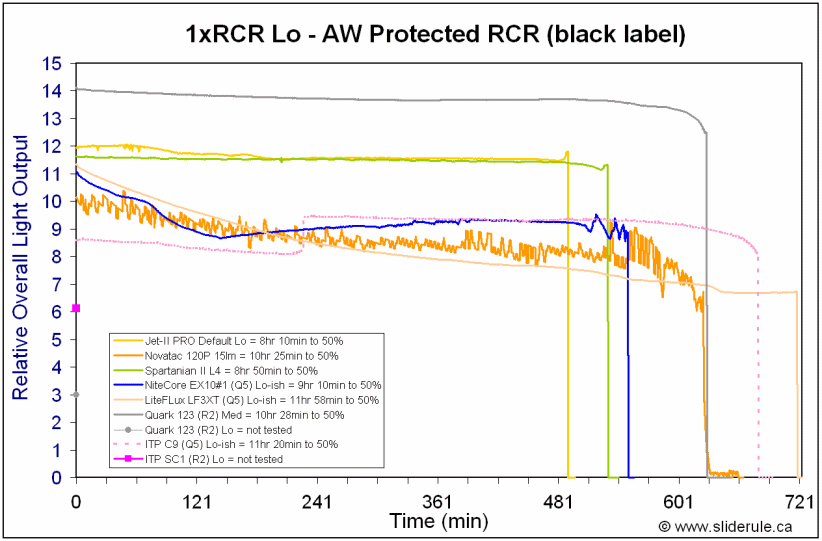
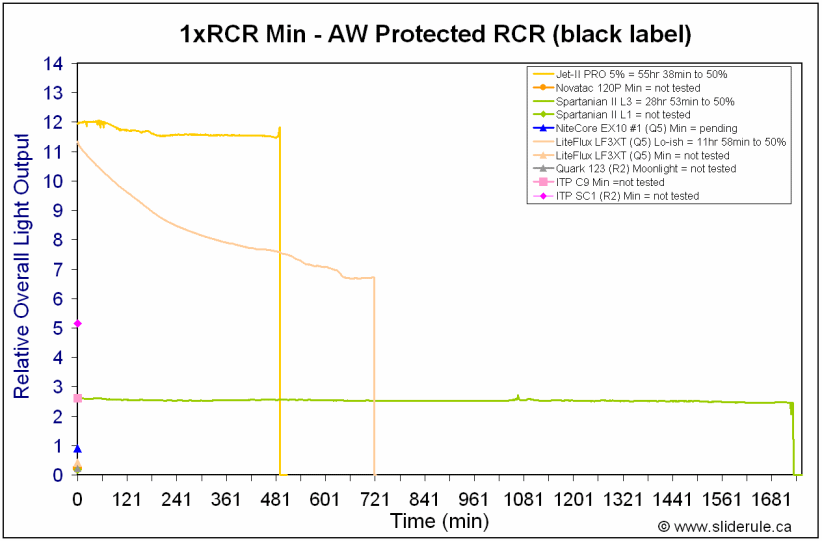
--------------------------------------
SC2 (2xR/CR123A) Comparison
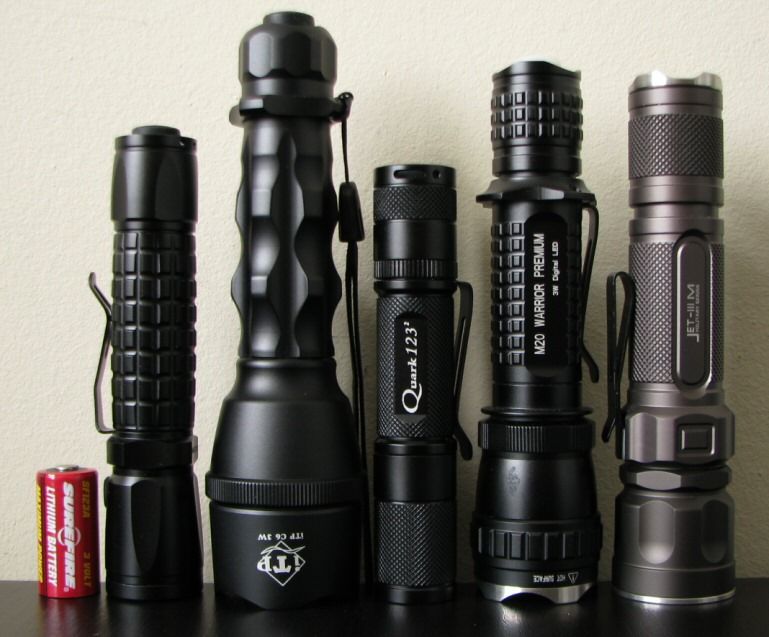

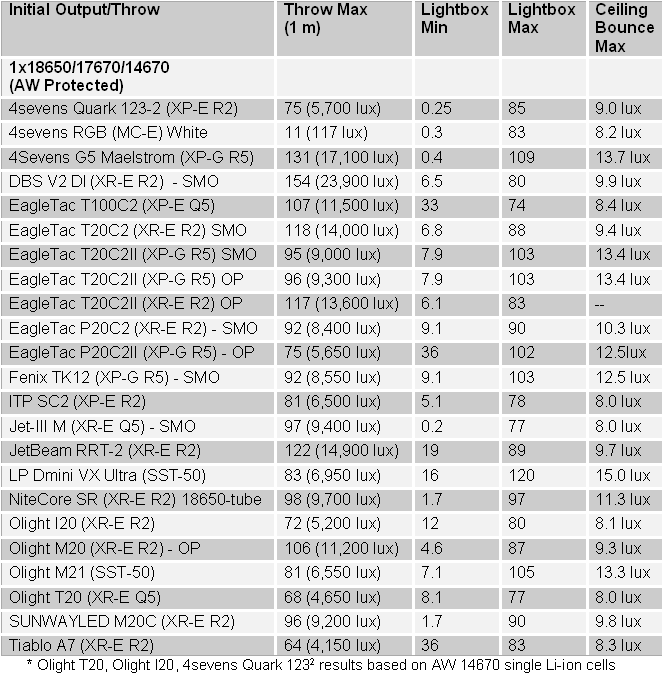
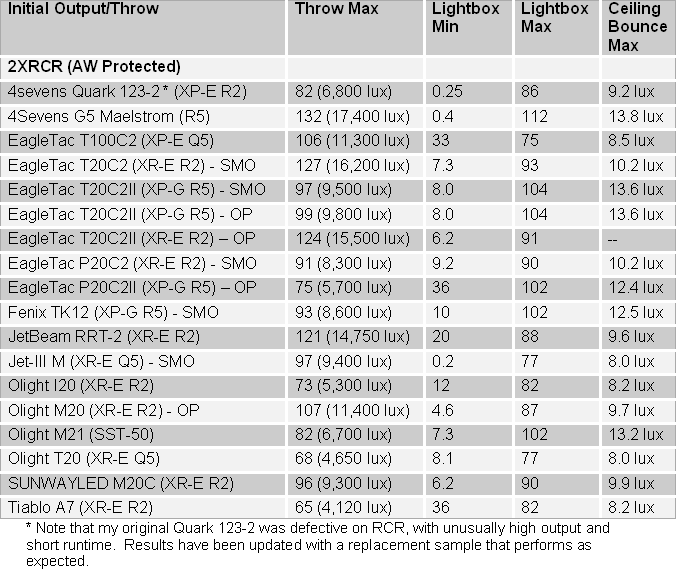
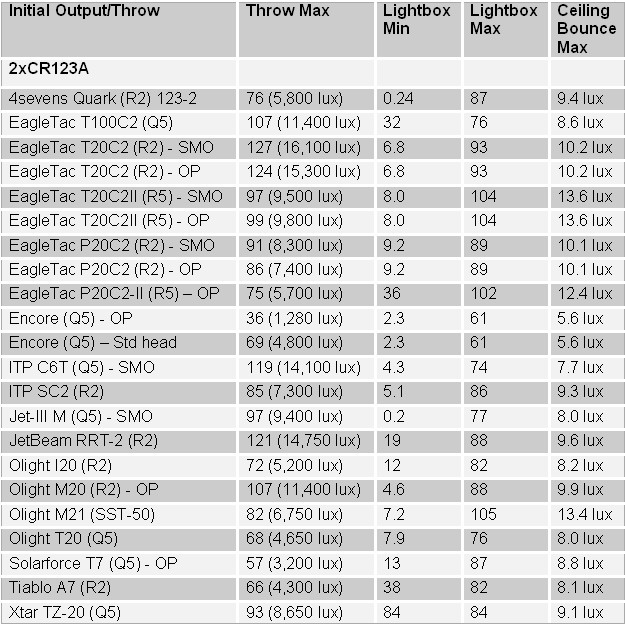
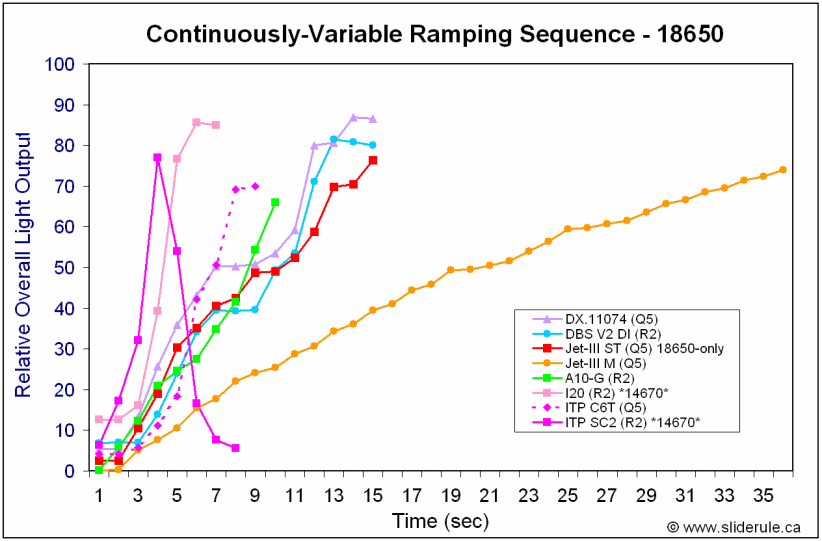
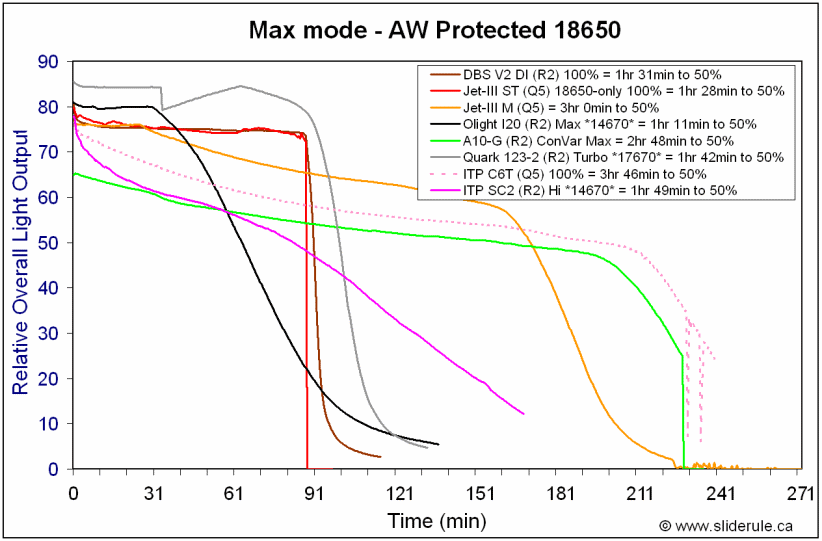
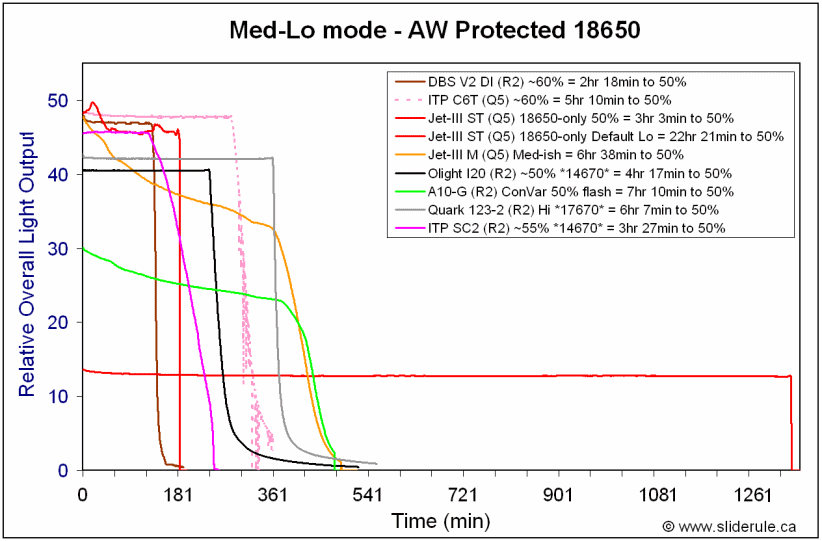
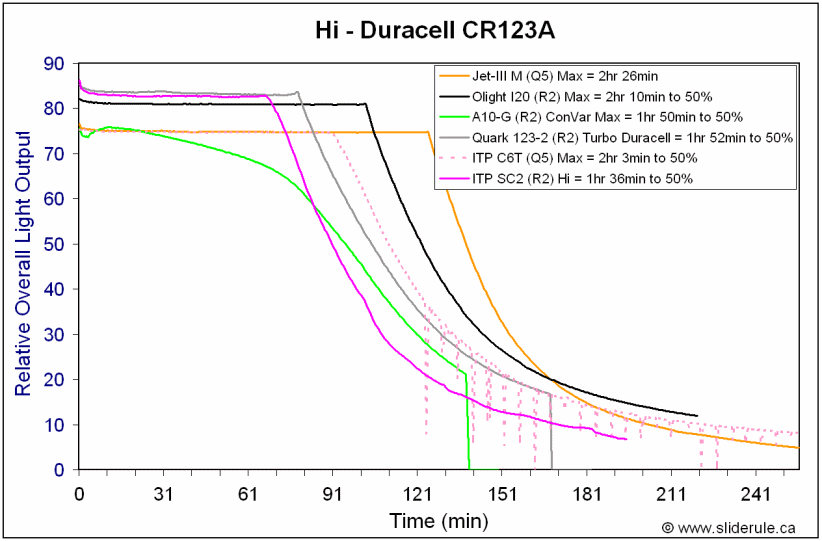
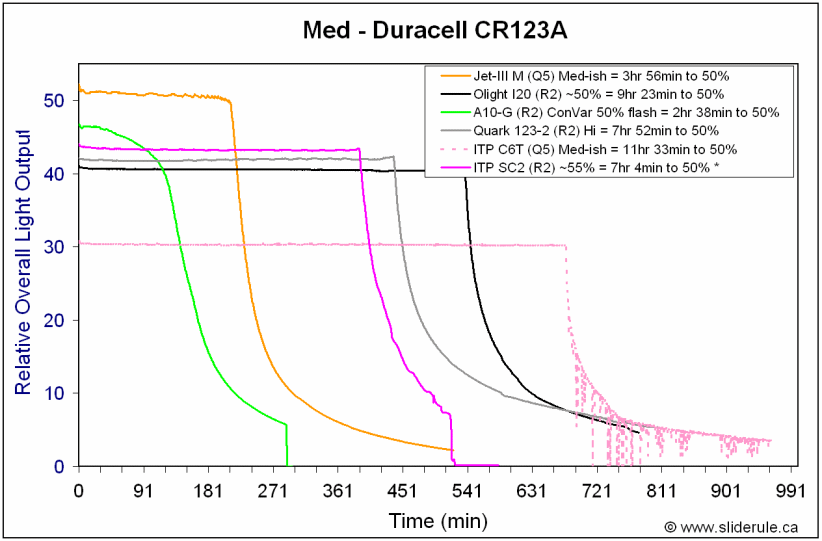
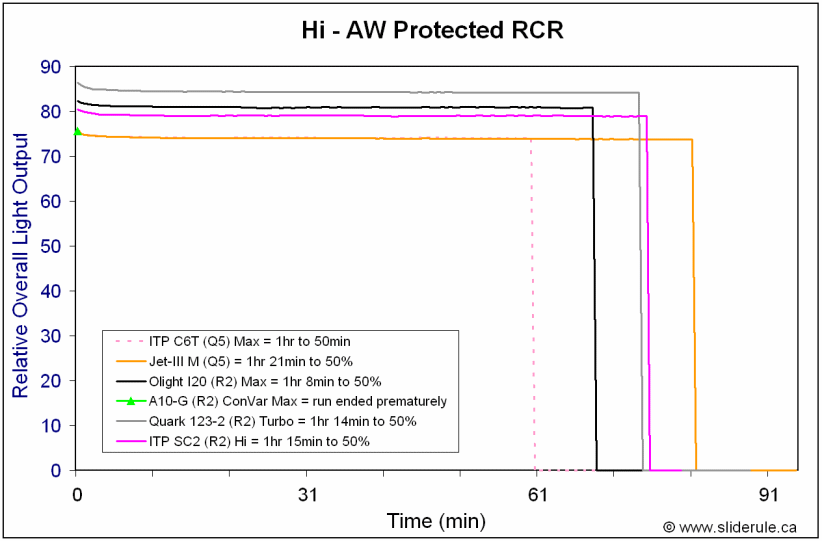
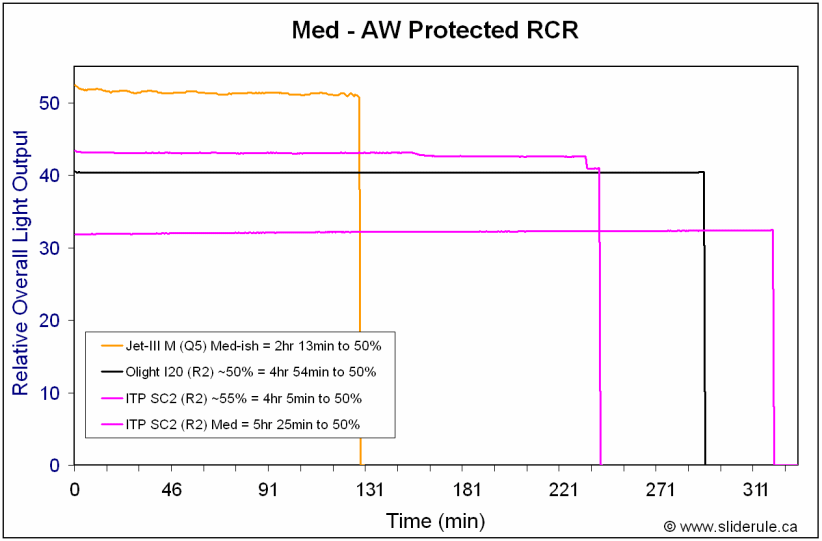
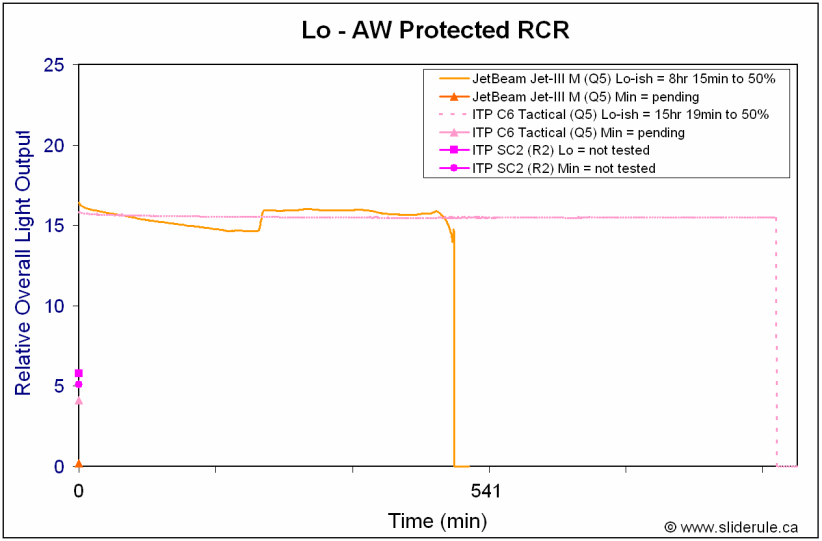
--------------------------------------
Potential Issues
Build quality is consistent with price, and is lower than more expensive offerings. Overall, the SA/SC family build is similar to the ITP A6 Polestar, but without the battery carrier (i.e. also have a front-mounted switch, relatively thin bodies, and a simple contact surface for the positive battery terminal).
The memory modes for the preset levels and the continuous ramp are independent of one another. While some may like this, it means you may be in for a visual shock if you have them set to widely different extremes. For example, if you leave the continuous ramp set at Max and the preset to Lo, when next you engage the ramp from the preset Lo it will jump immediately to Max and start to work down (i.e. it will not start ramping from the Lo preset you were on). As such, I found myself making sure that I kept the continuously variable mode saved to a relatively low level before switching to preset modes, to avoid switching back to something potentially too bright at a later time.
Min/Lo output mode is not as low as other continuously-variable lights (i.e. lacks a true Lo/Moonlight mode)
General Observations
I would consider these SA/SC series lights to be modern build replacements for the "budget-level" original ITP C7/C8/C9/C10 series.
In the context of general-purpose use, there are certainly a number of significant upgrades here: Higher output bin emitter (R2), more useful general-purpose beam (i.e. wider spillbeam, no rings), better checkering and clip for enhanced grip for carry, traditional head-mounted switch for output mode control, and the dual-control option of preset output modes or continuously-variable ramp. This last point is particularly impressive in a "budget" offering. oo:
oo:
Some of this comes down to simple preference – while I liked the original ITP/Olight head-twist mechanism for the ramp, I know most users prefer a button control. So kudos to them on the head-mounted switch (FYI, Mrs. Selfbuilt definitely prefers this new front button over the older twist interface ). And although it requires you to switch hand positions, at least it doesn't clutter the tailcap switch control (i.e. momentary is available). :thumbsup: And they thoughtfully included a reverse-clicky switch and low-rise boot cover, if you want to restore tailstanding ability (at the expense of momentary signaling, of course).
). And although it requires you to switch hand positions, at least it doesn't clutter the tailcap switch control (i.e. momentary is available). :thumbsup: And they thoughtfully included a reverse-clicky switch and low-rise boot cover, if you want to restore tailstanding ability (at the expense of momentary signaling, of course).
What hasn't changed is the tailcap lock-out or the excellent overall circuit efficiency. Performance is quite good at all levels tested. The dynamic range of the light is slightly reduced (i.e. it doesn't go as Lo as the previous series did). Note that the ramping speed has also increased considerably. Many users here seem to like this sort of fast ramp, but I personally prefer a more gradual one like the original C-series. :shrug:
Personally, I would like to see a removable clip option and a better contact surface for the positive battery terminal. Ideally, the option to swap heads on different bodies (where appropriate) would have been nice, but I guess something had to go to keep costs down. :shrug:
Also, while most will likely applaud the separate memory controls for preset levels and the continuous ramp, I would prefer to see the ramp start from whatever output level I am currently on when coming from the presets (i.e. instead of defaulting to what is in the continuous ramp memory mode and going from there). Oh, and have I mentioned that a lower Lo mode would really be nice?
But these issues aside, there is certainly no arguing with what you get here for the price. I see these lights doing very well for the general user, as a front head-mounted button is very intuitive for most people. And if you don't like seeing strobe in the preset sequence, there's always the continuously-variable mode for you to use.
All in all, a nice package falling into a fairly unique price/performance niche (i.e. higher-end budget category/lower-end flashaholic category).
Warning: Even more pic heavy than usual! This is will be a round-up review of all four lights.
Specifications for SA/SC family, according to BatteryJunction.com and GoingGear.com:
- LED Type: Cree XP-E R2
- Function: Low-Med-High-Strobe and Digital Infinite Beam Adjustment Output Levels
- Finish: HA Type III
- Reflector: Smooth Reflector
- Lens: Anti-shattering ultra clear lens, anti-scratching and anti-slip
- Water and Dust Resistant to IP68
- Switch: Tail switch for turning light on/off and Side switch for changing modes
- Mil-spec: MIL-STD-810F
- SA1: 1 x Alkaline, 1 x NI-MH, 1 x 14500 Battery, Size and Weight: L 107mm (4.21'') x D 26.5mm (1.04''), 67g (Excluding Battery)
- SA2: 2 x Alkaline, 2 x NI-MH Batteries, Size and Weight: L 156.5mm (6.16'') x D 26.5mm (1.04''), 86g (Excluding Batteries)
- SC1: 1 x CR123A, 1 x RCR123A, 1 x 16340 Battery, Size and Weight: L 90.5mm (3.56'') x D 26.5mm (1.04''), 54g (Excluding Battery)
- SC2: 2 x CR123A, 2 x RCR123A, 2 x 16340, 1 x 17670 Battery, Size and Weight:
L 124.5mm (4.90'') x D 26.5mm (1.04''), 69g (Excluding Batteries) - MSRP: ~$40 (all models)

The SA/SC series are replacements for ITP's original entries into the LED flashlight world, the C7/C8/C9/C10 lights. Please see my earlier reviews for details of those lights.
This will be a round-up review of all four new SA/SC lights. In the first part of the review, I will provide a general overview of the common build features and design. In the second part, I will provide detailed output/runtimes and size comparisons for each light, with some general comments at the end.
Note: The SC2 will be shown as a representative sample in the pics below.

In keeping with their budget status, the ITP SA/SC lights come in fairly basic packaging – but include a reasonable number of extras. These include a decent quality carrying pouch with closing flap, simple wrist lanyard, replacement o-rings and low profile tailcap button, and a reverse clicky tail switch. Also included is a warranty card and manual. Note the pocket clip is built-in to the light.
UPDATE: As several members have pointed out, the replacement switch and boot cap are a reverse-clicky with lower profile, allowing tailstanding.


Fit and finish were good on all my samples, with no flaws in the black type-III hard anodizing. Identification labels are sharp and clear on all samples (something that wasn't always the case on my early sample C7/C8/C9 lights).

The attached stainless steel clip and checkered body pattern help with grip. I found all samples reasonably comfortable to hold in the hand. Note the presence of the front switch, on the head above the clip. This switch is a reverse clicky, and is used to control output modes. The rear tailcap (forward-clicky) controls on-off - see UI discussion below.


Tail screw threads are anodized for tailcap lock-out. :thumbsup: Note the lights cannot tailstand in its default form with the forward clicky. However, you can swap in the reverse clicky switch and low profile boot cover (included in the package) to restore tailstanding at the expense of momentary-on.
Unlike the earlier C-series, the head is not user-removable. Here's a shot down the battery/body tube:

Similar to the budget MC-E-based ITP A6 Polestar, the positive contact surface is simply a piece of metal that has been folded-over. This is not particularly impressive. :sigh: There is certainly no physical reverse-polarity protection with this setup.


Unlike the earlier 2-stage reflector of ITP C-series and Olight T- and I-series lights, these new SA/SC lights have a smooth reflector that is not as deep. Actually, there seems to be very fine concentric rings all along the reflector, although these are subtle. They are likely there to help smooth out the beam somewhat.
These lights all use the new standard Cree XP-E emitter, with a R2 output bin (no tint bin reported). For those of you not familiar with tint bins, please see my Colour tint comparison and the summary LED tint charts found here.
For beamshot comparisons, I've chosen just the SA1 and SC2 below. All lights are on Max on either 1xSanyo Eneloop or 1xAW protected 14670/17670/18650 as appropriate, about 0.5 meters from a white wall.






Note that I do not have an ITP C10 to directly compare, so I've used the Olight Infinitum I20 for the second set of beamshots above. The I20 uses the same reflector and similar circuit as the C10, so is directly comparable.
First thing you will notice is that the beam pattern is completely different from the earlier ITP/Olight series lights. In fact, this new emitter/reflector setup produces a pattern that is very similar to the 4Sevens Quark series – a medium intensity hotspot with a very wide and relatively dim spillbeam.
The reflector seems to do a good job of producing a smooth transition from hotspot to spill without rings.
User Interface
The SA/SC series have an updated interface. Similar to other lights that use dual switches, the rear tailcap switch controls on-off and the front head-mounted switch controls output modes.
Default rear switch is a forward clicky, so you can press for momentary-on, click for lock-on. :thumbsup: You can substitute the reverse clicky replacement switch and low-rise boot cover if you prefer to have a tailstanding option (note that this would prevent momentary signaling, though).
Front switch is a reverse clicky, and works in two ways. To change between preset output modes, press and release the switch repeatedly until you get the mode you want. Sequence is Lo-Med-Hi-Strobe, in repeating order. The light has a memory mode, and will remember the last setting upon re-activation.
To run through a continuously variable ramp, press and hold the front switch. Initially, the light will ramp from Lo to Hi, and back down from Hi to Lo, in a repeating fashion. Release the switch to select the desired output level. The variable output feature has a separate memory mode, and will retain the relative brightness setting the next time you initiate a ramp. Note the ramp speed is fairly quick (i.e. ~3 secs, see ramp graphs for each model below).
Note that the preset Lo and Hi modes correspond roughly to Min and Max on the continuously variable ramp.

Strobe frequency was measured at just under 10Hz.
Consistent with earlier ITP/Olight continuously-variable lights, I was unable to detect the PWM frequency.
Testing Method: All my output numbers are relative for my home-made light box setup, a la Quickbeam's flashlightreviews.com method. You can directly compare all my relative output values from different reviews - i.e. an output value of "10" in one graph is the same as "10" in another. All runtimes are done under a cooling fan, except for the extended run Lo/Min modes (i.e. >12 hours) which are done without cooling.
Throw values are the square-root of lux measurements taken at 1 meter from the lens, using a light meter.
Note: Effective January 2010, all CR123A runtimes are now performed solely on Titanium Innovations batteries sponsored by a BatteryJunction.com. You can compare the generally excellent performance of these CR123A cells relative to the Duracell/Surefire cells used in all my erlier reviews here. I have marked all the new runtimes of lights with Titanium Innovations CR123As on the graphs with an "*".
Size Comparison Pics, Throw/Output Summary Charts, Runtime Graphs, and Ramping Graphs will be provided for each respective light below.
--------------------------------------
SA1 (1xAA) Comparison












--------------------------------------
SA2 (2xAA) Comparison









--------------------------------------
SC1 (1xR/CR123A) Comparison











--------------------------------------
SC2 (2xR/CR123A) Comparison













--------------------------------------
Potential Issues
Build quality is consistent with price, and is lower than more expensive offerings. Overall, the SA/SC family build is similar to the ITP A6 Polestar, but without the battery carrier (i.e. also have a front-mounted switch, relatively thin bodies, and a simple contact surface for the positive battery terminal).
The memory modes for the preset levels and the continuous ramp are independent of one another. While some may like this, it means you may be in for a visual shock if you have them set to widely different extremes. For example, if you leave the continuous ramp set at Max and the preset to Lo, when next you engage the ramp from the preset Lo it will jump immediately to Max and start to work down (i.e. it will not start ramping from the Lo preset you were on). As such, I found myself making sure that I kept the continuously variable mode saved to a relatively low level before switching to preset modes, to avoid switching back to something potentially too bright at a later time.
Min/Lo output mode is not as low as other continuously-variable lights (i.e. lacks a true Lo/Moonlight mode)
General Observations
I would consider these SA/SC series lights to be modern build replacements for the "budget-level" original ITP C7/C8/C9/C10 series.
In the context of general-purpose use, there are certainly a number of significant upgrades here: Higher output bin emitter (R2), more useful general-purpose beam (i.e. wider spillbeam, no rings), better checkering and clip for enhanced grip for carry, traditional head-mounted switch for output mode control, and the dual-control option of preset output modes or continuously-variable ramp. This last point is particularly impressive in a "budget" offering.
Some of this comes down to simple preference – while I liked the original ITP/Olight head-twist mechanism for the ramp, I know most users prefer a button control. So kudos to them on the head-mounted switch (FYI, Mrs. Selfbuilt definitely prefers this new front button over the older twist interface
What hasn't changed is the tailcap lock-out or the excellent overall circuit efficiency. Performance is quite good at all levels tested. The dynamic range of the light is slightly reduced (i.e. it doesn't go as Lo as the previous series did). Note that the ramping speed has also increased considerably. Many users here seem to like this sort of fast ramp, but I personally prefer a more gradual one like the original C-series. :shrug:
Personally, I would like to see a removable clip option and a better contact surface for the positive battery terminal. Ideally, the option to swap heads on different bodies (where appropriate) would have been nice, but I guess something had to go to keep costs down. :shrug:
Also, while most will likely applaud the separate memory controls for preset levels and the continuous ramp, I would prefer to see the ramp start from whatever output level I am currently on when coming from the presets (i.e. instead of defaulting to what is in the continuous ramp memory mode and going from there). Oh, and have I mentioned that a lower Lo mode would really be nice?
But these issues aside, there is certainly no arguing with what you get here for the price. I see these lights doing very well for the general user, as a front head-mounted button is very intuitive for most people. And if you don't like seeing strobe in the preset sequence, there's always the continuously-variable mode for you to use.
All in all, a nice package falling into a fairly unique price/performance niche (i.e. higher-end budget category/lower-end flashaholic category).
Last edited by a moderator:



